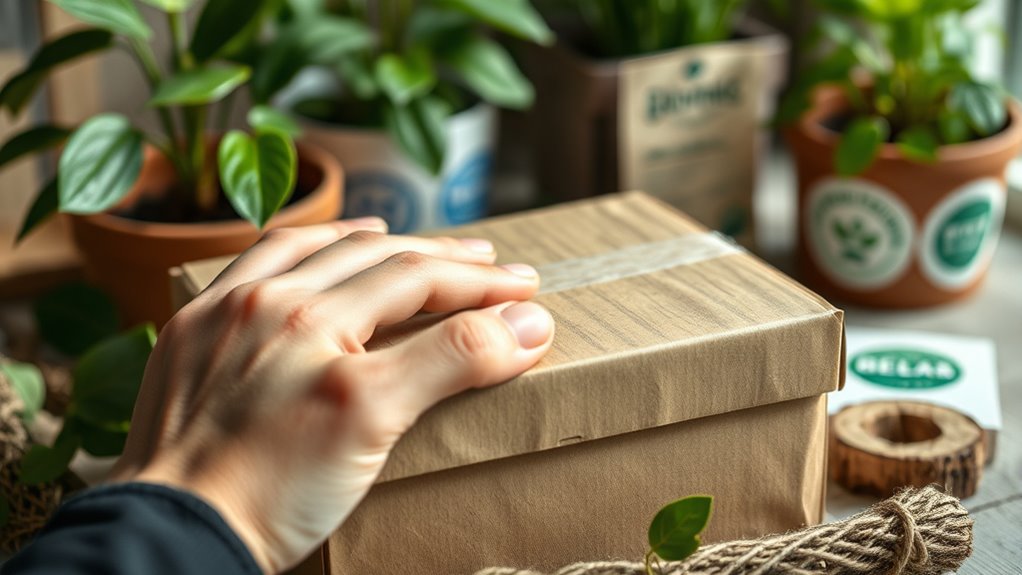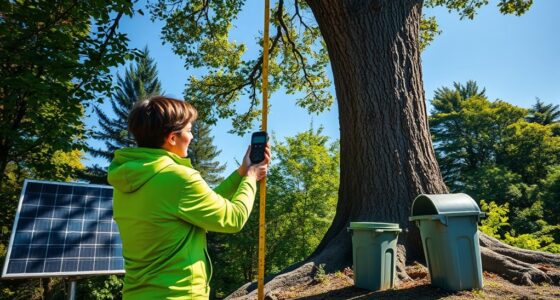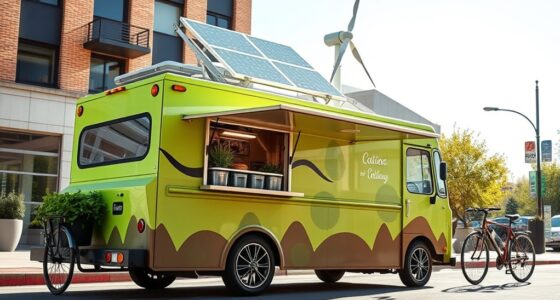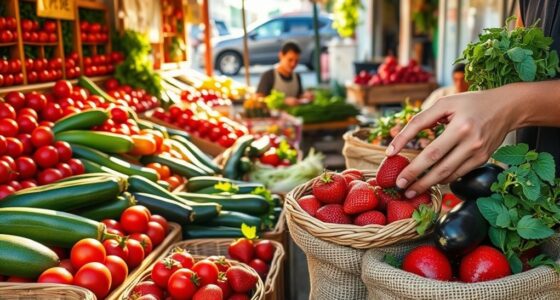Choosing low-impact, biodegradable packaging helps you considerably reduce your environmental footprint by cutting waste, pollution, and carbon emissions. Opting for materials that naturally break down within months instead of plastics that last centuries shows your commitment to sustainability. Prioritize products from responsible sources using renewable resources like plant-based fibers or bioplastics. These choices not only support a healthier planet but also boost your brand’s eco-conscious image. To discover more ways you can make a positive change, keep exploring this important topic.
Key Takeaways
- Select biodegradable materials like plant-based fibers or bioplastics that naturally decompose within months.
- Prioritize suppliers committed to sustainable, ethical sourcing of renewable raw materials.
- Opt for lightweight packaging to reduce transportation emissions and overall environmental impact.
- Incorporate eco-friendly branding to appeal to environmentally conscious consumers and enhance brand image.
- Aim for a circular economy approach by designing packaging that can be reused or easily composted after use.
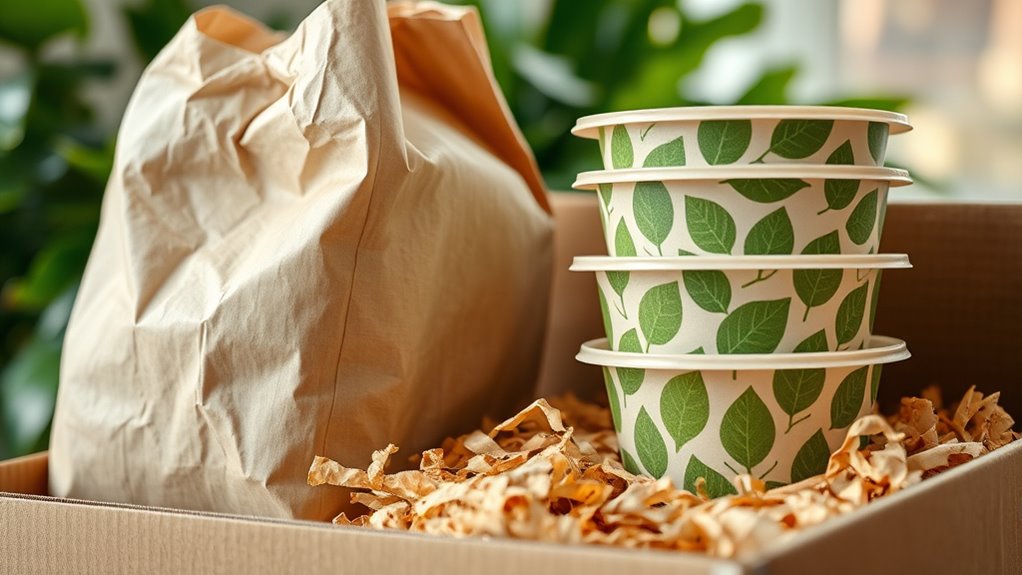
Have you ever considered how your packaging choices impact the environment? Every product you send out or receive is wrapped in some form of packaging, and these decisions add up over time. Opting for low-impact, biodegradable packaging isn’t just a trend; it’s a responsible choice that can considerably reduce your ecological footprint. When you choose biodegradable materials, you’re selecting options that naturally break down in the environment without leaving harmful residues. This means less pollution, less landfill waste, and a healthier planet for future generations. These materials are designed to decompose within a reasonable timeframe, often just a few months, unlike traditional plastics that can persist for hundreds of years. By switching to biodegradable options, you actively contribute to waste reduction and help combat the global plastic crisis. Incorporating biodegradable materials into your packaging shows your commitment to environmental sustainability and appeals to eco-conscious consumers. Sustainable sourcing plays an essential role in selecting eco-friendly packaging. When sourcing materials, look for suppliers who prioritize renewable resources and ethical practices. Sustainable sourcing ensures that the raw materials used for your packaging are obtained responsibly, without depleting natural resources or damaging ecosystems. For instance, choosing packaging made from plant-based fibers or biodegradable bioplastics derived from renewable biomass helps support environmentally friendly industries. These sources are replenishable and have a lower carbon footprint compared to conventional petroleum-based plastics. By making conscious choices about sourcing, you’re not only reducing your environmental impact but also supporting companies committed to sustainable development. It’s about aligning your business values with the growing demand for eco-conscious products. Another benefit of choosing biodegradable packaging is the positive brand image it fosters. Consumers are increasingly aware of environmental issues and prefer brands that demonstrate genuine commitment to sustainability. Using biodegradable materials and sustainable sourcing practices can differentiate you from competitors and build trust with your audience. It shows that you care about the planet and are willing to make responsible choices that reflect those values. Furthermore, many eco-friendly packaging options are lightweight and efficient to produce, which can reduce shipping costs and emissions. This dual advantage of environmental responsibility and cost-effectiveness makes biodegradable packaging an attractive option for forward-thinking businesses. Incorporating biodegradable materials sourced sustainably into your packaging strategy empowers you to reduce waste, lower pollution, and promote a circular economy. It’s a proactive step toward minimizing your environmental footprint and aligning your operations with global sustainability goals. By making these mindful choices, you’re contributing to a cleaner, healthier planet while satisfying the expectations of eco-conscious consumers. Ultimately, choosing biodegradable packaging backed by sustainable sourcing isn’t just good for the environment; it’s a smart move for your business’s future.
Frequently Asked Questions
How Do Biodegradable Packages Affect Product Shelf Life?
Biodegradable packages can slightly affect your product’s shelf life by influencing the degradation timeline. These materials are designed to break down faster, which may reduce their preservation effects compared to traditional packaging. You should consider factors like product type and storage conditions, as biodegradable packaging might require more careful handling to maintain freshness. Overall, with proper storage, biodegradable packaging can still effectively protect your products while supporting eco-friendly goals.
Are Low-Impact Packaging Options Suitable for All Industries?
You might wonder if low-impact packaging fits every industry, and the answer is not always straightforward. While many sectors benefit from biodegradable options, industry-specific applications and regional sustainability standards can influence their suitability. For some, these eco-friendly choices enhance brand reputation; for others, they may require adjustments to meet regulatory demands. Assess your industry’s unique needs and standards carefully—because the right packaging could be a game-changer.
What Are the Cost Differences Between Traditional and Eco-Friendly Packaging?
You’ll find that eco-friendly packaging often costs more upfront than traditional options, but a thorough cost analysis shows potential savings over time through benefits like brand loyalty and reduced waste management expenses. Market trends indicate increasing demand for sustainable solutions, which can lead to economies of scale and lower prices. By considering both initial costs and long-term value, you can make smarter choices that align with your budget and environmental goals.
How Can Consumers Identify Truly Biodegradable Packaging?
You can identify truly biodegradable packaging by looking for clear biodegradable labels and familiar packaging symbols, like the compostable or plant-based icons. Always read the labels carefully, as some products may claim eco-friendliness without certification. Trusted symbols indicate the packaging meets recognized standards, ensuring it breaks down naturally without harming the environment. By paying attention to these labels and symbols, you make more sustainable choices effortlessly.
What Are Future Innovations in Sustainable Packaging Technology?
Imagine packaging that dissolves in water within days. Future innovations in sustainable packaging focus on biodegradable materials like algae-based plastics and mycelium foam. These advancements aim to reduce waste and environmental impact. Companies are investing in biodegradable materials that mimic natural processes, creating packaging innovations that are stronger, versatile, and eco-friendly. These breakthroughs could revolutionize how you shop, making sustainability seamless and effective for the planet’s health.
Conclusion
By choosing low-impact, biodegradable packaging, you’re not just making a sustainable choice — you’re planting seeds for a greener future. Every small step you take ripples outward, transforming our planet one package at a time. Think of your decision as a beacon of hope, illuminating the path toward environmental harmony. So, embrace eco-friendly options today; after all, the earth’s future depends on the choices you make now.
